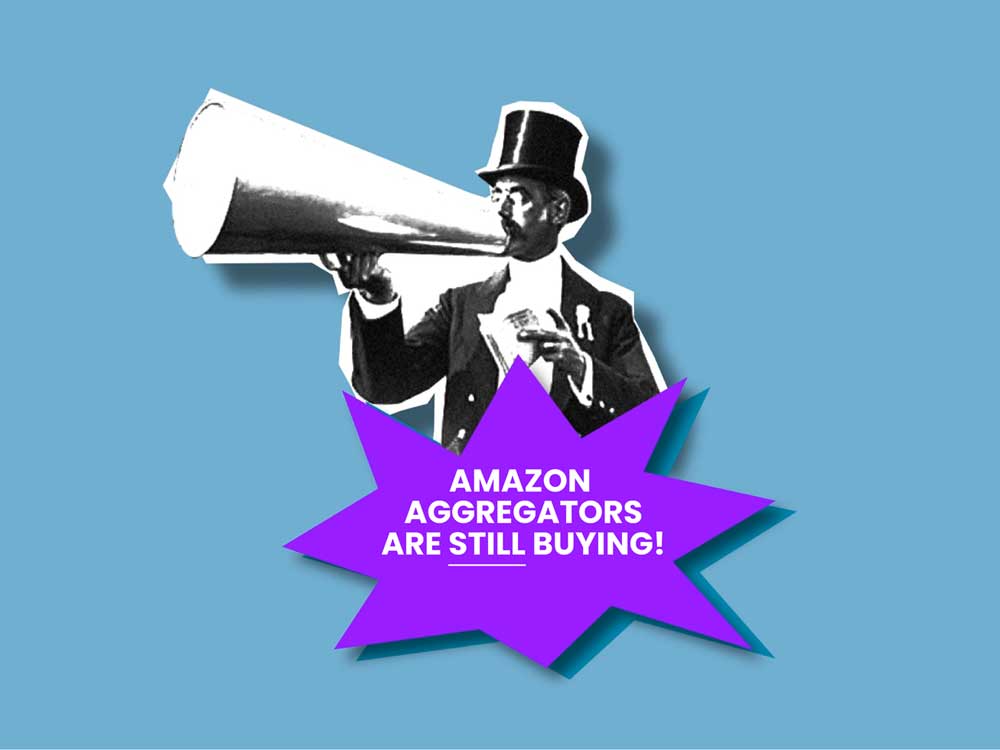We compare over 150 Amazon Aggregators to find the perfect buyer for your business
- – Search our database of active buyers
- – For fast tracked offers within 48 hours
- – And support from sellers already exited
- – To learn how we sold, click the button

Select your revenue and number of SKUs

Tell us your product category and profits
Reveal your unique list of potential buyers
Richard Turnbull and Martin Smith find ourselves in a unique position. Not only are we still two of the most active members of the Amazon seller forums, but we also have:
Amazon aggregators are businesses that acquire and consolidate smaller 3rd party brands selling on Amazon and Shopify.
The idea is simple:
Buy up (or aggregate) multiple Amazon FBA businesses, with the intention of either flipping them after a few years or holding out for an IPO.
Why?
Because one combined (or aggregated) business generating, say, $30m in annual revenue is worth considerably more than 30 smaller businesses generating $1m each in annual revenue.
Ultimately, it’s a numbers game.
And it is for this reason that so many investors have entered the aggregator space in recent years.
In fact, based on our research, there are now over 150 companies worldwide that fall into the Amazon aggregator category.
Each one is actively raising finance and competing against other aggregators to acquire smaller FBA and Shopify brands, just like yours.
Interested in finding out more?
Click here to compare over 150 aggregators in 3 simple steps. We will then reveal the select few companies that are most likely to offer you the highest valuation.
As a rough guide:
Amazon aggregators typically offer valuations (or multiples) based on the following annual profits.
So, using the guidelines above, a business generating $1m in annual profit could expect to achieve a valuation of somewhere between $4m-$5m.
A more important question, however, is “what number do they multiply?”.
Here’s why:
There are several different types of profit.
1. Gross profit
2. Net profit
3. EBITDA (Earnings Before Interest, Taxes, Depreciation, and Amortization)
4. SDE (Sellers Discretionary Earnings)
The last one, SDE, is probably the more commonly used by Amazon aggregators.
But what exactly is it?
Let us explain.
SDE is your net profit plus ‘add-backs’.
Add-backs are costs associated with the day to day running of your business (rent, R&D, staff costs etc) that the buyer will typically not incur once they have acquired it.
Fact:
Amazon aggregators already have large operational, storage and production facilities so your add-backs are often considerably more than you might think.
It is for this reason that we suggest using gross profit as a starting point for your SDE calculation.
By doing so, your valuation will be substantially higher than using net profit or EBITDA, for example.
But ultimately:
The profit figure and multiple used are, frankly, irrelevant.
To put that another way.
If one aggregator uses EBITDA with a 4x multiple and another uses SDE with a 4.5x multiple, the only figure you need to concern yourself with is the total (bottom line) valuation in dollar terms.
Interested in finding out more?
Click here to compare over 150 aggregators in 3 simple steps. We will then reveal the select few companies that are most likely to offer you the highest valuation.
Short answer:
It depends.
In our experience, Amazon aggregators look for several different things in a small business.
These include, but are not limited to:
Annual revenue
Profit margin
Product category
Number of SKUs
Countries of sale
% of Amazon sales
% of Shopify sales
Aggregators have certain cut off points for revenue, profit margins, number of SKUs, product category etc, but no two aggregators are the same.
For instance:
An Amazon aggregator may have purchased several brands in, say, the Household niche.
In this scenario, they are prepared to pay more for similar companies to complement their existing brands, and to scale with their already streamlined operations in the Household category.
Other aggregators may have already exhausted their quota of brands in one particular niche and are uninterested in further acquisitions.
Bottom line:
What might be considered favourable to one aggregator, may be a complete turnoff to another.
This can make the process of finding your perfect buyer (and achieving the highest valuation) extremely time-consuming.
Unless – ahem – you have access to a database to narrow down and match aggregators to your exact business profile and financials 🙂
But seriously:
There are aggregators out there that will give you, on paper, a knockout valuation.
Sadly, these are often too good to be true.
Both Richard and I (Martin) were offered incredible deals only to discover that the aggregator did not have the funds in place or, worst still were made by companies set up by Amazon sellers as a way of stealing information from their competitors.
So what does all this mean for you?
In short, there is no generic answer as to which aggregator gives the best valuation.
We can, however, help you to narrow your list of buyers and save you a ton of time and hassle in the process.
Interested in finding out more?
Click here to compare over 150 aggregators in 3 simple steps. We will then reveal the select few companies that are most likely to offer you the highest valuation.
As a successful Amazon FBA or Shopify seller, I suspect you have set blueprint for creating new products.
This includes everything from the initial research phase to sourcing suppliers, packaging, and finally, launching.
The process you follow has been tried, tested and refined over many SKUs.
But here’s the thing:
Whilst not all products hit a home run, they ALL take pretty much the same amount of time, energy, and money to launch.
My point?
Amazon aggregators undergo a similar set process when performing due diligence on smaller private label brands.
And get this:
It takes roughly the same amount of time to execute due diligence on an Amazon FBA business doing $1m in annual revenue as a business doing $20m.
With this in mind, during our many conservations with aggregators, we have observed the following.
1. There are very few aggregators that will look at businesses with less than $500k in annual revenue.
2. If your revenue is between $500k and $1m, you (or your numbers) need to prove that the business is growing, not declining.
3. Some aggregators are extremely picky with the deals they pursue, closing fewer (but significantly larger) acquisitions than the rest of the market. That being said, if your revenue is between $5m-$20m, you are in a strong position to hold out for a higher multiple.
And perhaps unsurprisingly:
4. If you have built a business generating $20m+ in annual revenues and your financials are solid (e.g impressive year on year growth), we have seen valuations of 8, 9 and even 10 times your Seller’s Discretionary Earnings (SDE).
Interested in finding out more?
Click here to compare over 150 aggregators in 3 simple steps. We will then reveal the select few companies that are most likely to offer you the highest valuation.
Let’s be honest:
It’s pretty tough out there at the moment.
To take a wild guess, I’m going to say that some (if not all) of the following issues have adversely affected your FBA business over the past year:
Amazon restock limits
Rising shipping costs
Product compliance
Organic search issues
Crazy costs per click
Overseas competitors
Compulsory insurance
Rising storage costs
Brexit (import checks)
Covid (staff shortages)
Plus many (many) more.
Simply put:
Your rolling 12 months financials are not as rosy as they could be.
Frustrating isn’t it?
Yes, but all is not lost.
In fact:
When it comes to selling your Amazon business, it’s more important to exit when the timing is right for the buyer, not the seller.
Let me explain.
Most Amazon aggregators use debt financing to fund their acquisitions.
In other words, money is released to them on the premise of buying companies. And crucially, aggregators must spend that money within a certain period of time.
This is great news for sellers.
Why?
Because aggregators are willing to give valuations based on what your 12-month profitability would have been (without the macro economic issues) or, for certain brands, what you forecast it to be.
Sound silly? It’s not.
So rather than waiting for the perfect set of 12-month financials (and letting Amazon send you loopy in the process), your time is better spent finding a buyer today.
Bottom line:
The window of opportunity is closing with many of your ‘mom and pop’ competitors having already sold up.
In fact, picture this.
In 6-12 months’ time, it’s quite possible that the first page of Amazon will be made up of brands owned by large multi-national aggregators with hundreds of specialist staff and (very) deep marketing budgets.
Gulp.
Interested in finding out more?
Click here to compare over 150 aggregators in 3 simple steps. We will then reveal the select few companies that are most likely to offer you the highest valuation.
When it comes to finding a buyer for your business:
The trick is to match the brand (and its financials) to companies that are actively looking for what you have to offer, at that exact time.
It sounds simple. And it is.
In fact, despite any reservations you have about the desirability of your niche, you will be amazed by just how many buyers come to the table.
So perhaps a better question is:
What product categories do Amazon aggregators not prefer?
Allow me to explain.
Fads (e.g. fidget spinners etc) are an immediate red flag.
Cheap, generic electronics are also a no go. Think of anything that can easily be copied by a lower-priced Chinese competitor.
If you’re selling either of these, it’s time to stop now and build a proper brand.
Next up:
Clothing.
Particularly if you have hundreds of SKUs with size and colour variations.
Nobody wants to inherit the cost of obsolete ‘out of fashion’ inventory, let alone the headaches of ordering it in the first place.
Supplements?
It depends on the aggregator.
Some have built their entire business around the supplement category and are more than happy with the risk (and undoubted rewards) within that niche.
For others, whilst they may consider mainstream vitamins and minerals, they draw the line with, say, fat burners and testosterone boosters.
In short:
Amazon aggregators are not silly.
They like strong established brands, with products that resonate with a loyal customer base, and a solid set of financials.
In our experience, a small number of SKUs is preferable, with a heavy concentration of sales via Amazon FBA.
As for product category?
Apart from the odd exceptions (see above), anything goes.
Interested in finding out more?
Click here to compare over 150 aggregators in 3 simple steps. We will then reveal the select few companies that are most likely to offer you the highest valuation.
Once again:
It’s impossible to provide a definitive answer to this question.
And the reason?
Because each Amazon aggregator has specific buying criteria, and even that can change from one acquisition to the next.
Some aggregators insist on a diverse mix of sales whereas others prefer 100% only Amazon businesses.
Of course:
If you invested significant time and money in a highly optimised Shopify store, for example, this is certainly not going to hinder your deal.
In fact.
Sales outside of Amazon FBA can be extremely attractive, to the right buyer.
We have seen deals where the seller had – incredibly – managed to wean their business off Amazon FBA to the point where orders from Shopify, eBay, and Esty made up nearly 50% of sales.
Pretty impressive, right?
We think so.
As Warren Buffett famously said:
Diversification is a protection against ignorance.
And certain Amazon aggregators would agree.
Indeed, in the 50% Amazon FBA, 50% non-Amazon deal above, we had three separate aggregators bidding against each other for the right to acquire the brand.
The seller eventually held out for a 6+ times multiple, and good on him.
With that being said:
It’s important to note here that DTC (Direct to Customer) channels, like Shopify, represent their own challenges.
As I’m sure you’re already aware.
Third-Party Logistics (3PL) fulfilment and shipping costs make DTC profitability a harder nut to crack, especially when compared to the crazy-cheap fees of Amazon FBA.
So what does all this mean?
Well, it’s safe to say that if orders from Amazon FBA represent between 90% to 100% of your total sales, practically every Amazon aggregator is going to be interested in taking a closer look at your business.
Subject to the usual revenue and margin thresholds, already discussed.
If you have significant non-Amazon sales, your time is best spent talking to us first, rather than wasting precious energy researching the entire market.
Make no mistake:
Regardless of sales concentration, there is an Amazon aggregator out there for each type of business.
The trick is to find them before they snap up your competitors.
Interested in finding out more?
Click here to compare over 150 aggregators in 3 simple steps. We will then reveal the select few companies that are most likely to offer you the highest valuation.
The question on every seller’s lips.
And rightly so.
In fact, other than sky-high offers, the remarkably short timescales to exit is something that draws more and more FBA sellers to Amazon aggregators.
Think about it this way:
In as little as 30 days, you could be handing over the reins of your business and the weight of all the associated responsibility.
Sounds good, doesn’t it?
Of course:
The exact timescales vary from business to business and not every sell completes within a month.
What’s the sweet spot?
30-60 days in our experience, give or take a week on either side.
But before you jump ahead, there are one or two things to consider.
First up:
You need to prepare your business for sale.
To do this, watch step two of our three-step video series.
The same information is also found in our Definitive Guide To Amazon Aggregators.
Next:
You are going to want to speak directly with the head of acquisitions at each aggregator, not the junior staff answering their emails.
If your brand and financials fit the profile, it’s time to sign a Letter Of Intent (LOI).
But not before you have:
1. Read our ‘What can you and should you negotiate?’ question
2. Talked to your accountant to figure out the total taxes payable
3. Discussed the pros and cons of the offer with a lawyer
When does the 30-60 day timer start?
The second you sign an LOI.
Which effectively ties you into an exclusivity period with one aggregator only.
Now:
The terms of most LOIs will state that the buyer (aggregator) has between 60 to 90 days to close.
And whilst this period is negotiable, it means that you’re unable to discuss offers with other prospective buyers until the LOI term has lapsed.
Make no mistake:
Due diligence is intensive and things can crop up unexpectedly.
It is for this reason that most Amazon aggregators will insist on a 60 to 90-day term within the LOI, despite this being longer than the average 30-60 day ‘offer to exit’ period.
Interested in finding out more?
Click here to compare over 150 aggregators in 3 simple steps. We will then reveal the select few companies that are most likely to offer you the highest valuation.
Here’s an interesting fact:
Of the 300+ post and pre-exit sellers we have spoken to, more than 40% were willing to accept the first offer on the table for their business without any form of negotiation.
Incredible.
But that’s not all.
You see:
Whilst the majority of successful FBA sellers are experts in the complexities of making money on Amazon, all but a few have ever sold a business.
Worst still:
They are, as one buyer put it, “extremely green” when it comes to negotiations.
Not good.
Especially if you’re presiding over a multi-million dollar offer, or two.
So what can you do about it?
Well, first up (and perhaps unsurprisingly), we strongly recommend talking to other Amazon sellers who have already been through the process of exiting their FBA business.
In fact:
We know a couple of regular dudes who are more than willing to assist.
Ahem 🙂
But seriously, if you don’t fancy talking to either Richard or myself (Martin), try asking around in the Amazon seller forums or Facebook groups for advice.
But what types of things can you negotiate?
In our experience:
1. The offer, in (absolute) dollar terms
2. The type of deal (asset or share)
3. The upfront cash percentage
4. The LOI exclusivity period
Let’s look at each one in turn.
First up, the offer.
If you haven’t already heard, Amazon aggregators have purchased a lot of businesses.
It’s what they do.
With this in mind, most aggregators have a highly refined process for valuing FBA brands and can usually give you an opening offer within 48 hours of receiving your financials.
But here’s the kicker:
Whilst practically every Amazon seller will obsess over the ‘multiple’ (or multiplication of their annual profits) they’re being offered, this is ultimately irrelevant.
Why?
Because the only thing that really matters is how much money will you put in your pocket, in absolute dollar terms.
Makes sense, right?
In fact this leads me, conveniently, onto the type of deal you agree to.
You see:
The offer and the deal structure carry equal weight in terms of your net take-home payout and absolutely must not, therefore, be considered in isolation.
Simply put.
You could, on paper, be presented with a knock out deal, only to discover that the gross (pre-tax) valuation is infinitely higher than what you actually put in your back pocket (net, after all taxes have been paid).
This can be as much as 45% lower, in some cases.
We go into this in more detail on our Asset vs Share deal page, which is – in our opinion – a must-read before proceeding.
Next up?
The up-front cash percentage.
Or to put that another way, the split between the cash you receive on closing versus the longer-term potential ‘earnout’.
This is where it gets interesting.
Of course:
Some sellers are more than happy to accept (say) 70% up front with 30% paid over a one or two year period, subject to the business hitting specific profitability targets.
For others?
80% or even 85% cash on closing is the absolute minimum required to hand over their business.
Bottom line?
All of this, of course, must be clearly stated in the LOI before commencing with due diligence.
The exclusively period within the LOI being the fourth and final item to negotiate.
‘Exclusivity’ meaning the length of time you are effectively unable to talk to other buyers, between signing the LOI and closing.
What’s the norm?
In our experience, 30-60 days is considered ‘doable’ for most aggregators.
That being said:
If you’re keen to push the sale through quickly, a 30-day exit is possible.
It also provides the required motivation (on both sides) to avoid delays during due diligence.
Interested in finding out more?
Click here to compare over 150 aggregators in 3 simple steps. We will then reveal the select few companies that are most likely to offer you the highest valuation.
Despite what you may have heard:
Due diligence is not the all-consuming monster most people make it out to be.
In fact, it’s not even close.
Of course:
You will need to dedicate adequate time to help the buyer get into the weeds of your business.
How long?
In our experience, most sellers will invest somewhere between 20 and 30 hours.
This is a given.
But here’s the deal.
Unlike those long, protracted ‘horror story’ exits we’ve all read about in the forums, due diligence with an Amazon aggregator is, by contrast, an absolute breeze.
Let me explain.
Firstly:
Practically every aggregator works off a pro-forma (master) due diligence document.
Setup in Google Drive and shared with you upon signing the LOI, this one document contains a complete list of everything you need to supply.
Nice and simple.
Remember:
Most Amazon aggregators will have connected SellerBoard to your Seller Central account.
Since this already summaries your key financials, providing backup copies of (say) your stock invoices, should be a piece of cake.
Next up?
Video calls.
More specially, you will be asked to attend a series of web-based meetings to discuss the primary functions of your business.
These include:
Among several others.
This is the stage in due diligence where you’re going to want to bring your ‘A Game’.
Bottom line:
Present your business in a clear and concise manner, answering any questions as comprehensively as possible.
Now:
One of the challenges of due diligence is that your business, naturally, must continue to trade.
This can prove cumbersome when updating the buyer’s due diligence documents for sales and stock, since these are changing on a daily basis.
If that’s not enough.
You will, of course, have to juggle the stress of running the business in parallel with selling it.
Our best advice here?
Simply accept the fact that, for a few weeks only, you’re going to be busier than normal.
Trust us.
Due diligence is really no biggie. And it’s certainly not worth getting irritated or overwhelmed over.
Top tip:
Whilst you should already be more than equipped to supply the information requested, there are two documents that will further streamline your due diligence.
First up?
A supplier agreement.
I’m not talking about a complex 100-page legally drafted document.
Just a short headline summary of your payment terms, unit costs, quality control steps, and so on.
The document should be signed by both parties, with a declaration that each unit produced will comply with your exact specifications.
This leads me to:
A product specification sheet.
Again, this should be a clear, user-friendly breakdown of each SKU, including everything from dimensions, smell, and colour, right down to the thickness of the outer packaging, with pictures.
In a nutshell.
Approach due diligence with a positive outlook and well-prepared documentation.
This will make the entire process smooth and painless.
Above all?
Give the buyer confidence that the foundations of your brand are solid and that you have a business that’s worth investing in.
Interested in finding out more?
Click here to compare over 150 aggregators in 3 simple steps. We will then reveal the select few companies that are most likely to offer you the highest valuation.
This figure represents the estimated amount of money spent by Amazon aggregators to acquire FBA businesses since 2020
We can save you hours of research by identifying the Amazon aggregators that are most likely to buy your business. We can also introduce you directly to the senior decision-maker at each aggregator, not the junior staff answering their contact forms. Finally, and having recently sold our FBA businesses, we will be on hand to guide you through the entire process, from offer to exit.
We do not charge you a fee for our service but may receive a commission if a sale goes through. That commission comes out of the aggregator’s marketing budget, not from what you receive. So unlike a broker that charges 7-10% of the sale price, you get the full 100% payment when selling your business. To read more about our service, click here.

Before you head off into the craziness of Q4, there is some light relief in the form of White Label World Expo...

And so, here we are. A full 12 months have passed since we closed on the sale of our Amazon FBA businesses....

If you take a closer look 'under the hood' of Andy Jassy's short time at the helm of Amazon, two subtle shifts...

On the face of it, Amazon aggregators and ecommerce aggregators look like the same thing. Except for one crucial difference.

Over the past couple of weeks, Richard and I have spent time at the sharp end of some of the biggest transactions...

I've lost count of the number of articles that I've read recently that state, categorically, that the FBA aggregator 'bubble' has burst.
The process of selling our Amazon FBA businesses was all-consuming, but boy did we pick a ton of valuable experience along the way. If you’re new here, we strongly recommend checking out our 2023 Definitive Guide to Amazon Aggregators. Written for time-precious FBA sellers, this simple, easy to follow document takes less than 5 minutes to read and represents the culmination of over 100 hours of research into the Amazon aggregator space. To access the guide today, click this link.
